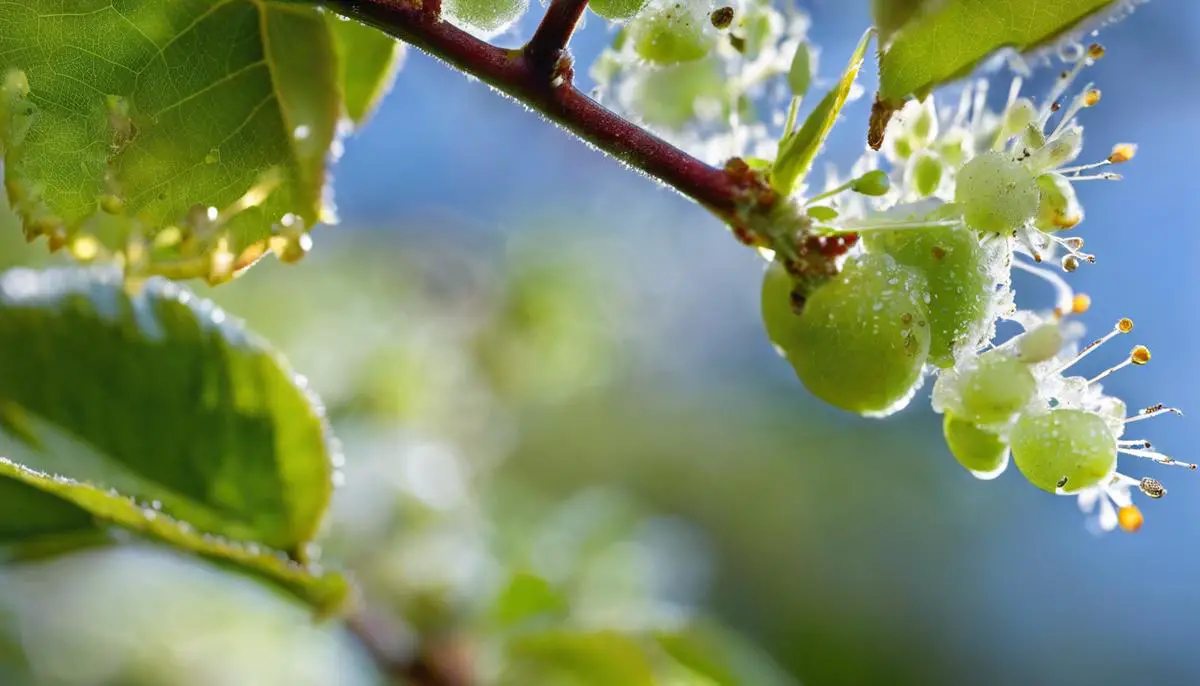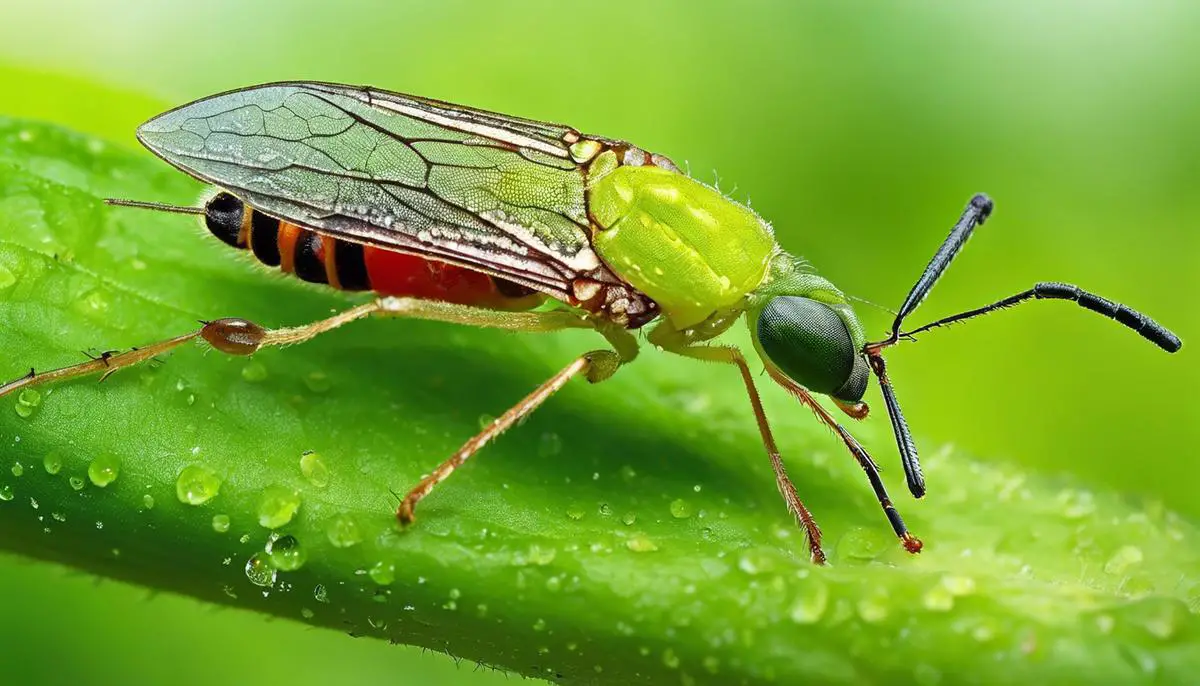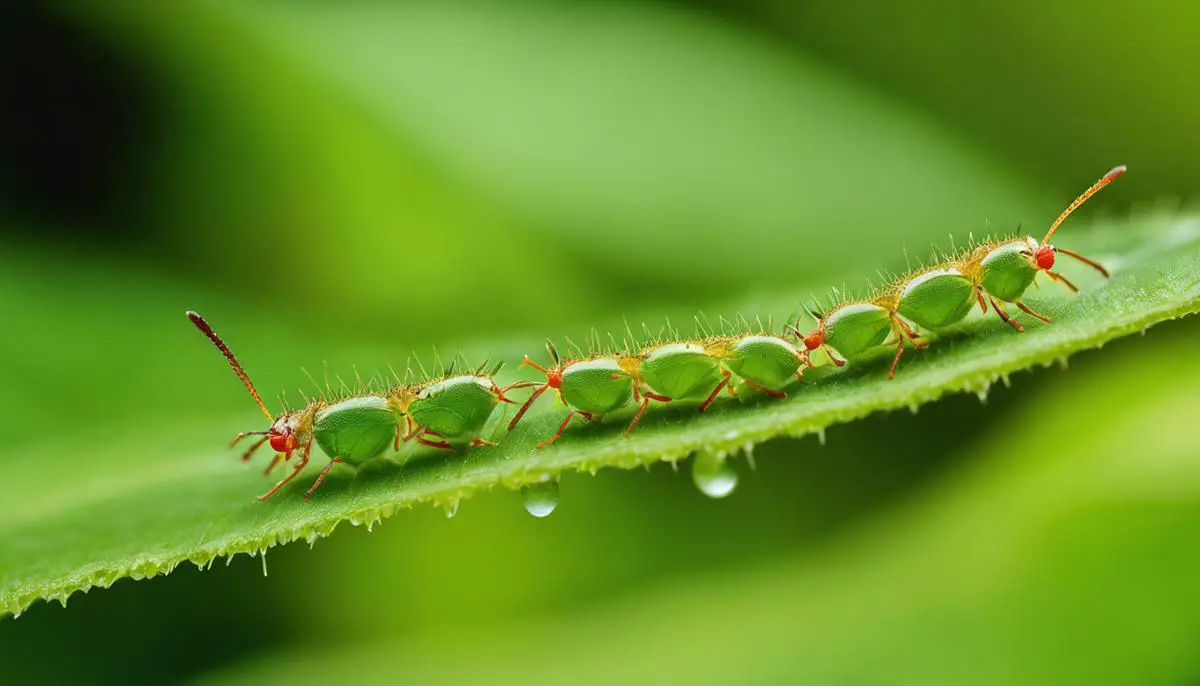Imagine walking through an apple orchard, the branches heavy with the promise of crunchy, juicy fruit. But then something catches your eye. A horde of miniscule, pear-shaped insects, clumped together and wreaking havoc on your beloved apple trees – these are aphids. Notorious for their destructive habits, aphids can pose a real threat to apple trees, siphoning vital nutrients and causing detrimental harm. This essay delves into the world of these tiny trespassers, starting with their identification, including their appearance, lifecycle, and the damage they do to apple trees. Beyond mere identification, we also explore the intriguing realm of natural pest control, shedding light on aphids’ natural predators and how they can be harnessed to manage aphid populations. Lastly, we delve into viable organic aphid treatments, showcasing various pesticides and homemade solutions that can keep your apple trees aphid-free.
Aphid Identification
Aphids Invasion: A Closer Look and Their Effect on Apple Trees
In the world of apple tree cultivation and maintenance, few things are as frustrating – or as common – as a rampant infestation of aphids. Understanding what aphids look like and the havoc they can wreak on apple trees is the first step in managing these pesky invaders.
So, what do aphids look like? These small, soft-bodied insects usually measure less than 1/8 inch in length. Their color can vary from green to yellow, black, or brown, depending on the species. Aphids are pear-shaped and possess two long, thin tubes called cornicles projecting from their posterior end, a distinctive feature amongst their insect counterparts.
On closer examination, one might notice shiny, sticky residue, also known as honeydew, left behind on the tree leaves and around their feeding area. Honeydew can encourage the growth of sooty mold, giving the leaves and fruit a blackish tint. Observing clusters of these insects or honeydew residues are telltale signs of an aphid infestation.
But how exactly do aphids affect apple trees? The primary issue lies in their feeding habits, as they extract sap from plant tissues, leaving the tree visibly distressed. Typical symptoms include curled, yellowing leaves and a general stunting of tree growth. They can also transmit diseases or viruses, posing a more serious threat to the health and vitality of apple trees.
Beyond feeding, aphids pose another significant issue – the secretion of the aforementioned honeydew. This sticky substance can attract ants, which further exacerbate the problem as they aid in aphid colonization.
When it comes to aphid prevention, regular inspection of trees is critical. It’s often easier to address a small invasion than to try and combat a full-blown infestation. Establishing beneficial insects such as ladybugs, lacewings, or parasitic wasps can aid in keeping aphid populations in check.
For instances, where prevention was not successful, insecticidal soaps, neem oil, or horticultural oil sprays can help manage an existing infestation. On a larger scale, dormant oil sprays should be considered in late winter or early spring for severe infestations.
Remember that balance is key. Aphids are a natural part of the ecosystem, and a small presence won’t be catastrophic, but a keen eye and early intervention can prevent these tiny adversaries from becoming a significant hindrance to the health and productivity of apple trees. As caring cultivators, the objective is to maintain a harmonious environment that allows apple trees to thrive despite the aphid’s best efforts.

Natural Pest Control
Harnessing the Power of Predators: A Natural Solution to Aphid Control
In the battle against the strenuous aphid infestation, often, the best warriors come from nature herself. Weaving an intertwined web of ecology, these predators don’t just help maintain the balance, but skillfully turn the tide in your favor. Do not underestimate the role of these preeminent predators. Introducing them into the ecosystem could be the defining tactic in subduing the aphid menace.
Lady Beetles, also known as ladybugs, are a renowned natural predator of aphids. These voracious predators, with their domed, brightly-colored bodies, display an impressive appetite for aphids, feeding off of these pests at a rapid rate. Introducing lady beetles into your orchard or garden is an environmentally friendly way of reducing aphid populations. A word of caution: it’s crucial not to resort to insecticides when lady beetles are present, as these will harm or kill the beneficial beetles as well.
Next up, lacewings, with their green or brown bodies and large, transparent wings, are avid aphid hunters. Known as ‘aphid lions’, lacewing larvae are especially predatory, consuming vast quantities of aphids through their developing stages. Adult lacewing insects, while less predatory, still contribute to the population control of aphids.
Another advantageous ally comes in the form of hoverflies, sometimes referred to as flower flies or syrphid flies. The larvae of these flies are avid aphid predators, keeping these pests at bay. Meanwhile, adult hoverflies serve as key pollinators, adding another layer of benefit to their introduction.
It’s also worth noting the crucial role of parasitic wasps in managing aphid populations. While the term “parasitic” may flinch a few faces, these wasps are nothing short of valiant troopers in the war against aphids. They lay eggs inside aphids; when the eggs hatch, the larvae consume the aphid from the inside, leading to the demise of the aphid and the birth of a new wasp. This ingenious predation system will aid significantly in reducing aphid numbers.
Incorporating insect-attracting plants, such as yarrow, dill, or alyssum, near your apple trees can draw these predators to your garden. It’s a smart way to welcome these beneficial insects into the ecosystem, combating aphids while encouraging biodiversity.
By the same token, diversity is a crucial ally in your orchard’s health and the struggle against aphids. Polyculture, or the practice of growing different types of plants together, can confuse and deter aphids, making it more challenging for these pests to thrive.
While aphid control can seem daunting, remember that you are not alone in this endeavor. Nature provides her own legion of skilled predators, ready to assist in the fight. By welcoming these beneficial predators into your garden or orchard, you can cultivate a much healthier, more balanced ecosystem, and simultaneously beat back the aphid invasion. Sometimes, the best defense is a good offense – let nature lead the charge.

Organic Aphid Treatments
Diving into aphid control now, an important and organic way to keep these apple-loving nuisuances at bay involves using home-made garlic sprays. Pungent and strong smelling, garlic is a natural aphid repellent. The concentrated garlic extract can be sprayed directly onto the foliage of the apple trees. Use about two bulbs of garlic and puree them in a blender with a small amount of water, strain the mixture, then add water to dilute. Typically, ten parts water to one part garlic is an effective solution. Spray on affected plants.
Another organic solution involves using dish soap and water. It’s easy, cost-effective, and pretty much everyone has access to the ingredients. Mix about one tablespoon of dish soap with a quart of water. Spray the mixture directly on aphid colonies for best results. The soap dissolves the protective layer on the aphid’s body, causing them to dehydrate and die.
But be warned, this solution should be used with caution as it can harm beneficial insects as well. Avoid spraying during the day when pollinators are most active. A late evening spray session is best. Plus, it gives the solution the chance to work overnight when aphids are most active.
Diatomaceous earth, a non-toxic powder consisting of ground fossils from marine life called diatoms, also works wonders. When aphids crawl over it, the diatoms pierce their exoskeleton, causing them to dry out and perish. Sprinkle this natural powder around the base of your apple trees and on any nearby ants, who might be robbing your trees of their natural defenses by farming the aphids.
But don’t forget, your first line of defense will always be a healthy and robust apple tree. Aphids are actually more likely to infest trees that are stressed due to drought, disease, or lack of nutrients. A well-mulched, irrigated, and fed tree will have fewer issues with pests than one that’s not.
These methods can help you manage the aphid population in your apple orchard and ensure that your trees continue to thrive. Now that you’ve gained this knowledge, don’t be shy about sharing it with your fellow apple tree growers. Remember, a healthy tree is a happy tree.

Ensuring the healthy growth of our apple trees often requires diligent efforts, vigilance, and an understanding of how to deal with threats like aphids effectively. A comprehensive understanding of these tiny pests, right from their identification to their life cycles and the damage they cause to our trees, forms the cornerstone of effective aphid management. Integrating natural pest control measures can not only ensure healthy and sustainable gardening practices but also provide a fascinating insight into the ecological balance of nature. Leveraging the power of organic aphid treatments further strengthens our arsenal against aphid invasions, reducing our reliance on harmful chemicals. Remember, every aphid-free apple is a testament to your careful protection and trees’ resilience. Let the crunch of every bite echo the success of your organic aphid management efforts.